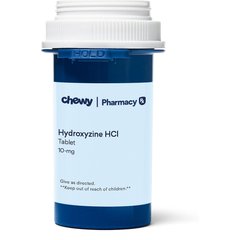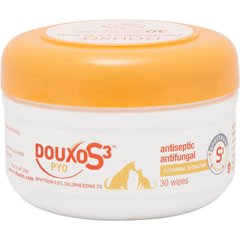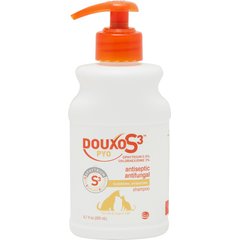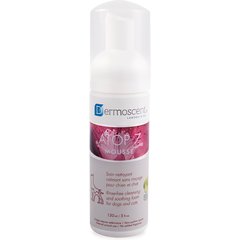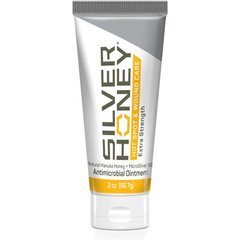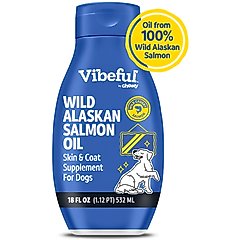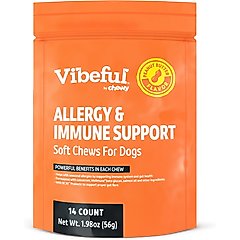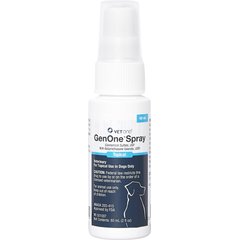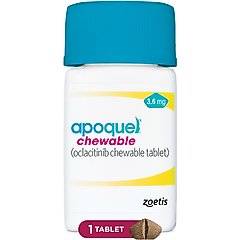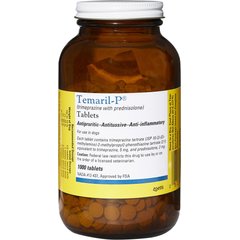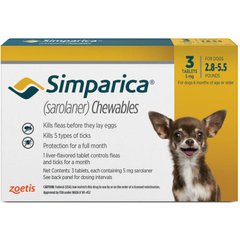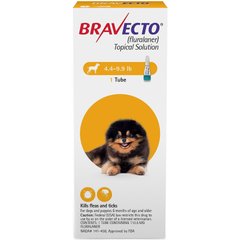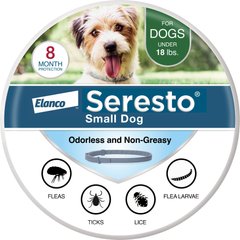What Can I Give My Dog for Allergies?

Photo by Chewy
Have you seen your pup scratching more? How about hair loss? What you might be seeing your poor pup suffer through are allergies, which are fairly common in dogs and can manifest in many ways, from skin and ear infections to itchy and red skin.
Fortunately, there are many options for treating a dog’s allergies, including topical therapy, medications, prescriptions, and nutritional management.
Talk to your veterinarian before starting any treatment for allergies.
Key Takeaways
- Over-the-counter antihistamines like Zyrtec can sometimes help dogs with mild allergy symptoms.
- Common symptoms include itching, sneezing, and skin irritation.
- Diet changes or prescription medications may be necessary for chronic issues.
- Never give your dog medications without talking to your veterinarian first.
- Identifying the root cause of allergies in your dog is necessary for effective treatment.
Types of Allergies in Dogs
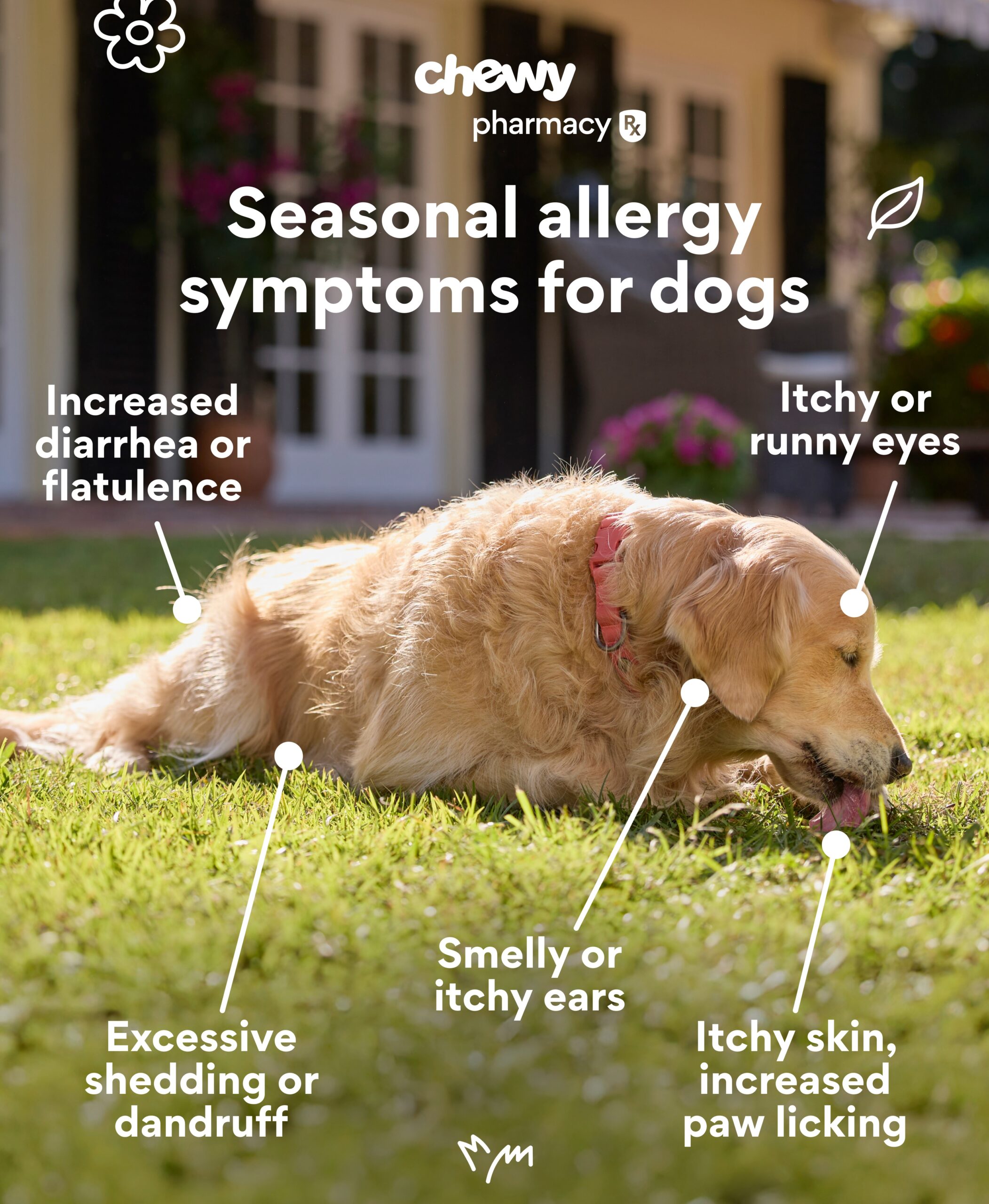
Photo by Chewy
There are three types of dog allergies: flea allergy dermatitis, environmental allergies, and food allergies.
Flea Allergy Dermatitis (FAD)
FAD is caused by an allergy to flea saliva and is the most common type of allergic reactions in dogs.
FAD typically causes inflammation along the lower back, tail base, and thighs. Common signs include:
- Licking/chewing
- Scratching
- Redness
- Hair loss
- Raised bumps (papules)
- Hot spots
You may also find dark specks of flea dirt in your dog’s fur—but not always if they only have a few fleas or are bitten intermittently.
FAD is typically treated with prescription medication, over-the-counter (OTC) medication, or allergy shots, as determined by your veterinarian. Prescription flea prevention given year-round is crucial for dogs with FAD.
Environmental Allergies, Such as Seasonal Allergies
About 30% of the U.S. dog population suffer from environmental allergies (also called atopy).
While dogs with atopy may be seasonally itchy around their face, paws, and armpits, other dogs are itchy year-round depending on their location. Recurrent ear infections are also common in dogs with atopy.
Atopy is usually first seen in dogs ages 6 months to 3 years of age. Secondary skin infections with yeast and bacteria are common.
Seasonal allergies are typically treated with prescription medication, OTC medication, or allergy shots, as determined by your veterinarian.
Food Allergies
When a dog reacts to an ingredient in the food, usually a source of protein, they usually have a food allergy.
The most common allergens for dogs are protein in nature and include:
- Beef
- Dairy
- Chicken
- Wheat
- Soy
- Lamb
Less-common allergies include corn, egg, pork, fish, and rice.
Food allergies are far less common: about 0.2% percent of dogs can suffer from food allergies. But for dogs who do have it, food allergies tend to be non-seasonal (year-round), and affected dogs are usually fed the offending ingredient for two years before developing signs.
Dogs who have a food allergy are itchy around their rump, armpits, groin, face, and in between their toes. They also often have concurrent flea allergy dermatitis and/or atopy.
In general, the following symptoms are associated with allergies in dogs:
- Excessive itchiness as evidenced by increased self-scratching, chewing, licking, and/or rubbing skin on carpet or furniture
- Red skin
- Hair loss
- Swelling of face, lips, eyelids, or ears
- Red bumps or pimples on skin
- Increased skin odor
- Thickened skin that is darkened
- Red paws that may be stained brown from excessive licking
- Increased odor, discharge, and itching from ears (ear infection)
- Itchy, runny eyes
- Excessive dandruff
- Vomiting, diarrhea, excess gas (typically seen with food allergy)
- Sneezing
Food allergies in dogs are typically diagnosed with a food-elimination trial and treated with a hypoallergenic diet.
What Can I Give My Dog for Allergies?
There are a few ways to go about treating the symptoms, including topical medications, supplements, and prescriptions.
However, check in with your veterinarian before treating your dog for allergies. They will recommend the best treatment for your pet.
Over-the-Counter Medications
To treat seasonal allergies, your veterinary may recommend OTC allergy medicine for dogs, such as antihistamines.
Antihistamines
OTC products are branded for humans and are not currently FDA-approved as a veterinary medication.
However, the active ingredients are utilized commonly in the veterinary field, and veterinarians can legally prescribe human drugs in animals in certain situations. This is called extra-label, or sometimes off-label use, because this use isn’t described on the drug label.
It’s important to note that not all human OTC medications are safe for animals, so you should never give a human medication to your pet unless under the specific guidance or direction of your veterinarian.
Furthermore, if your dog has a skin infection, external parasites, or food allergies, using an OTC product may not help and may make it worse. If your dog is not responding, consult with your veterinarian.
Below are commonly prescribed OTC antihistamine options followed by their effectiveness at treating dogs with seasonal allergies (atopy):
- Cetirizine (Zyrtec): 15%
Recommended Product
- Chlorpheniramine: 8.9–10%
Recommended Product
- Diphenhydramine (Benadryl): 6.7%
Recommended Product
- Hydroxyzine: 6.7–10%
Recommended Product
- Loratadine (Claritin): 0%
These percentages are based on the number of itchy dogs who responded positively to antihistamines in a 1999 study. Newer research shows that Zyrtec did not perform any better than the placebo at managing allergies in dogs. In practice, antihistamines produce variable results, and it may be necessary to try several before finding one that is effective for your dog, per your vet.
Topicals
If your dog has seasonal allergies, your vet may add a topical to their treatment plan to help prevent itching. Topicals include:
- Wipes, like Douxo S3 PYO Antifungal Wipes
Recommended Product
- Shampoo, like Douxo S3 PYO Antifungal Shampoo
Recommended Product
- Mousse, like Dermoscent Atop 7 Mousse
Recommended Product
- Spray, like Vetericyn Plus Hot Spot Spray
Recommended Product
- Ointment, like Silver Honey Hot Spot Ointment
Recommended Product
When bathing a dog for allergies, follow these tips:
- Leave the lather on your dog for five to 10 minutes before rinsing and thoroughly rinse the shampoo with cool water.
- Do not use hot water because it can dry their skin and make the itching worse.
- Bathe itchy dogs no more than one to two times per week to control itching.
Discuss the addition of any topical to your dog’s treatment plan with your vet and follow their specific directions.
Supplements
Some dogs with seasonal allergies may benefit from fish oil supplementation or taking a probiotic.
Fish Oil
Studies have shown that fish oil supplements, like the Vibeful Wild Alaskan Salmon Oil Skin & Coat Supplement, help reduce inflammation associated with skin allergies and help skin cells maintain a strong barrier against allergens.
Recommended Product
You can give a dog too much fish oil, however, and fish oil is not indicated for all dogs. So, consult with your veterinarian on the appropriate dosage before giving fish oil to your dog.
Probiotics
Supplementing an allergic dog with probiotics may help reduce inflammation in the body and rebalance their gut immune system.
Here’s how it works: Allergies are due to inflammation and an abnormally hyper-reactive immune system. The largest immune system in the body is called the GALT, and it is in the gut. Unhealthy or inflamed intestines with abnormal gut bacteria can contribute to allergies.
Do not supplement dogs with human probiotics, as human gut bacteria are different from canine. Use a canine-specific product, like the Vibeful Allergy & Immune Support Soft Chews Supplement.
Recommended Product
Prescription Medications
Sometimes, OTC options for dog allergies are not enough, and you need something from your veterinarian that is prescription-strength to stop the itch.
Fortunately, there are many allergy meds for dogs available that can be used alone or in combination with home remedies for dog allergies to provide the right amount of relief for your dog, including:
- Prescription topical treatments
- Prescription oral treatments
Always make sure you tell your vet about any current treatments, medications, or topicals you are using on your pet, as they can potentially interact with prescription meds.
Topical Treatments
If your dog has an itchy, red, hot spot, Animax Ointment may help. It’s a prescription topical treatment that combines a corticosteroid, an antifungal, and an antibiotic.
Recommended Product
Topical sprays containing a steroid, like VetOne GenOne Spray, are often prescribed for local, itchy hot spots as well.
Recommended Product
Oral Treatments
If OTC oral antihistamines, fish oils, and topical products aren’t cutting it, then your vet may explore oral prescription dog allergy treatment options for your itchy dog.
Previously, the only oral prescription options available were steroids, like prednisone, prednisolone, and triamcinolone. While these medications did stop allergy symptoms, they also came with a whole host of negative side effects, including increased appetite, increased water consumption and urination, and increased susceptibility to infections, to name a few. Steroids are also less effective with food allergies.
Oral and injectable steroids are still used and prescribed in some dog allergy cases, but your vet will help decide if they are the best option for your pet.
Atopica
Atopica is the brand name for cyclosporine, an FDA–approved medicine for dogs with atopic dermatitis. Most veterinarians will require annual blood work and an exam to fill this prescription.
Recommended Product
Atopica is generally considered safe but can cause vomiting, diarrhea, or loss of appetite in some dogs.
Atopica must be given one to two hours before food or two hours after food; and it takes four to six weeks to provide relief. Steroids may be prescribed to your dog in the interim to control allergy symptoms.
Your veterinarian may recommend keeping Atopica in the freezer to help lower the chance of negative side effects.
Apoquel
Apoquel is another prescription allergy relief for dogs that starts working in four hours and helps stop the itch within 24 hours. It works by targeting and inhibiting the itch and inflammation signaling pathway.
Recommended Product
Given with or without food, Apoquel is typically administered twice daily for up to 14 days, and then once daily for maintenance.
Apoquel may be prescribed seasonally or year-round, depending on your dog’s level of itch and allergies. It should not, however, be given to dogs with existing parasitic skin infestations or pre-existing cancers.
Temaril-P
Given to control seasonal or flea allergies, Temaril-P is an oral prescription allergy medication that combines the antihistamine trimeprazine with the steroid prednisolone.
Recommended Product
Because Temaril-P contains a low dose of steroids, the following side effects may be seen:
- Increased drinking and urinating
- Potbelly
- Poor wound healing
- Changes in their hair coat
Allergy Shots
If your dog has moderate to severe allergies or requires daily medication, your vet may recommend allergy injections.
There are two main allergy shots available:
- Traditional allergy shots created by a skin or blood test
- General prescription option, Cytopoint
Traditional Allergy Shot
The traditional allergy shot requires that you take your dog either to your local veterinarian or a veterinary dermatologist for allergy testing, which involves:
- Giving your dog a blood test or doing a skin prick test. The skin prick test is considered more accurate and is usually only done by veterinary dermatologists.
- Creating an allergy serum, once the test is done.
- Administering the allergy serum via a series of injections; it is intended to desensitize your dog over time to the allergens that cause them grief.
These allergy shots, otherwise known as hyposensitization subcutaneous immunotherapy, are the only way to truly reduce the instances of allergy symptoms. All other treatments are aimed at controlling symptoms.
Cytopoint
Cytopoint may be a good option if your dog has moderate to severe allergies or cannot tolerate oral medications.
Administered as an injection by your veterinarian, Cytopoint starts providing relief within one to three days and controls allergic itching for four to eight weeks.
Cytopoint works by targeting and neutralizing interleukin 31 (IL-31), a chemical messenger in your dog’s body that makes them itchy.
Only available through your local veterinarian, Cytopoint has a low incidence of side effects.
Hypoallergenic Diet
Food allergies can only be diagnosed by a food-elimination trial, which requires a dog to eat a hypoallergenic diet for eight to 12 weeks. This is because it takes about 20 days for canine epidermis (skin) to turn over and at least six weeks for previous allergens to clear out.
If all the itching goes away on the new diet, then it is likely that your dog has a food allergy. If that is the case, then you have two options:
- Stay on the hypoallergenic diet.
- Slowly start to reintroduce foods into your dog’s original diet and see if the symptoms return. This is called a diet challenge.
Most pet parents understandably don’t want the itching to return, so they elect to keep feeding their dog the hypoallergenic diet.
If your veterinarian has recommended a diet trial, it’s important to follow their food recommendations precisely.
Hydrolyzed Diets vs. Novel Protein Diets
There are two main types of food to choose from for diet trials:
- Hydrolyzed diets, which are foods that are manufactured to remove allergens
Recommended Product
- Novel protein diets, where you feed your dog a protein and carbohydrate that they have never eaten before
Recommended Product
Over-the-counter diets are not considered good hypoallergenic choices for food trials, because they are often manufactured on machines that make other diets. Hypoallergenic diets generally are created on dedicated machines that are meticulously cleaned to prevent cross-contamination with allergens.
Your vet will determine the best diet for your dog.
Flea and Tick Medication
It’s important to keep your dog on year-round flea prevention. Your vet can help you determine the best flea and tick medication for your pet.
Here are some common options to discuss with your vet:
- An oral monthly preventive, like Simparica
Recommended Product
- An oral medication for infestation, like Capstar (only lasts 24 hours)
Recommended Product
- A topical monthly preventive, like Bravecto
Recommended Product
- A flea and tick collar, like Seresto (lasts eight months)
Recommended Product
Treat the Environment To Reduce Allergens
If you have a dog with allergies, then you also need to think about treating the environment your dog lives in, especially if your dog suffers from flea allergies or atopy. They include:
- Flea control
- Reduce expose to allergens
- Combination of therapies
Flea Control
If your dog has a flea allergy, then the bite of just one flea can drive them crazy.
Use flea control on all dogs and cats in the household year-round to keep flea allergies under control.
Be sure you use a flea and tick treatment formulated specifically for each type of pet. In other words, don’t give your cat a flea and tick treatment formulated for dogs, and vice versa.
Reduce Exposure to Allergens
If your dog is prone to seasonal allergies, then you need to reduce exposure to allergens. Here’s how:
- Check your HVAC filter monthly and change or clean the filter as needed.
- Cover bedding with an allergen barrier.
- Wash pet bedding once a week during allergy season with a gentle, hypoallergenic laundry detergent.
- Vacuum your home often to remove dust, mites, pollen, and dander.
- Plug in some air purifiers.
Recommended Product
FAQs About Allergy Medicine for Dogs
Q: What human allergy medicine is safe for dogs?
A: Human antihistamines are often used off-label to reduce symptoms of atopy and other allergies in dogs. However, all antihistamines have the potential for side effects and may interact with other medications that your dog receives.
Always consult with your primary veterinarian to determine which allergy treatment will be safe and effective for your pet.
Q: Can you give a dog Benadryl for allergies?
A: Yes, in some cases, your veterinarian may recommend Benadryl for your dog. However, it is only effective to treat allergies in approximately 7% of cases.
If your dog is itchy, talk to your vet about the options.
Q: Is Zyrtec or Benadryl better for dogs?
A: Some dogs may respond positively to Zyrtec, while others will have better results with Benadryl.
Because results are variable and unpredictable, your veterinarian may advise you to try several antihistamines (testing one brand at a time) to determine the best choice for your dog. In many cases, antihistamines are more effective when used in combination with other therapies, rather than relying on the antihistamine alone.
Q: How much Zyrtec can I give my dog?
A: Never give OTC human medication unless directed to do so by your veterinarian. If your dog is itchy or showing signs of allergies, please reach out to your vet to discuss the right medication for your pet.
Attributions
This content was medically reviewed by Kelly Gold, DVM, Chewy veterinarian.



